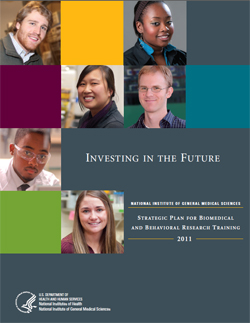 We have just posted the final version of Investing in the Future: National Institute of General Medical Sciences Strategic Plan for Biomedical and Behavioral Research Training. Fifteen months in the making, the plan reflects our long-standing commitment to research training and the development of a highly capable, diverse scientific workforce.
We have just posted the final version of Investing in the Future: National Institute of General Medical Sciences Strategic Plan for Biomedical and Behavioral Research Training. Fifteen months in the making, the plan reflects our long-standing commitment to research training and the development of a highly capable, diverse scientific workforce.
In an earlier post, I shared the plan’s four key themes.
As you’ll see, the plan considers training in the broadest sense, including not just activities supported on training grants and fellowships, but also those supported through research grants. It strongly encourages the development of training plans in all R01 and other research grant applications that request support for graduate students or postdoctoral trainees. And it endorses the use of individual development plans for these trainees as well as the overall importance of mentoring.
Finally, the plan acknowledges that trainees may pursue many different career outcomes that can contribute to the NIH mission.
My thanks to the dedicated committee of NIGMS staff who developed the plan and to the hundreds of investigators, postdocs, students, university administrators and others who took the time to give us their views throughout the planning process.
We’ve already started implementing the plan’s action items. While there are some that we can address on our own, others will require collaboration. We will again be reaching out to our stakeholders, and we look forward to continued input from and interactions with them to achieve our mutual goals.


I think that it is an excellent idea to require a mentoring plan on R01 grants for PIs requesting funds for graduate students and post docs. How will you enforce this requirement and how will you follow up to see that the plan was adhered to. Have you thought about putting more money into training grants and reducing funds for training on R01s. The advantage of this approach is that the NIH will have a mechanism to ensure that the training is taking place.
I agree completely that NIH needs to have some oversight on the funds used for training students. One mechanism, as you suggest, would be to reduce the award on R01’s and divert that money into training grants. Another approach might be to make programs and institutions accountable for the training environment. Institutions (universities, departments, programs…) that can demonstrate a rigorous training environment with a selective admissions process, clearly defined standards for retention and advancement, and good outcomes data for its PhD graduates, should be allowed to permit their grad faculty to support students from individual research grants. Institutions that can not support these claims, and therefore can not ensure an adequate training environment, should not allow their faculty to support PhD trainees from individual research grants. Award size should be adjusted accordingly. Also, institutions should be able to demonstrate that they have rigorous standards for their graduate faculty in terms of training and mentoring not just scientific productivity, which is not necessarily correlated with training and mentoring.
It is a little less top-down, and a lot more enforceable, than asking the NIH to decide whether an individual investigator is a good mentor. New faculty don’t have a mentoring track record, but if they are in a good environment for grad student training, they will likely be, formally or informally, mentored in mentoring. Their students will have been more selectively admitted, and have a higher potential for success. In other words, focus on the overall training environment, rather than the individual research group. And make the institutions, not the individual PIs, accountable for supporting a training environment.
Think about this: If an inexperienced PI gets an R01, but they are not in a great grad program, they will spend their time and money on students without a high probability of success. The PI’s productivity will suffer-so that is a loss for the NIH and for the PI. The student will maybe complete their degree, if the bar is low enough (awesome, right?), or they won’t complete. They will get paid, but they will have wasted their time in a field for which they are not suited-a loss for the student. So who gains? Well, the university has received revenue, in the form of tuition payments from the PI’s R01, for four, or five or six years for that student. Gain for them.
Do you like that equation?